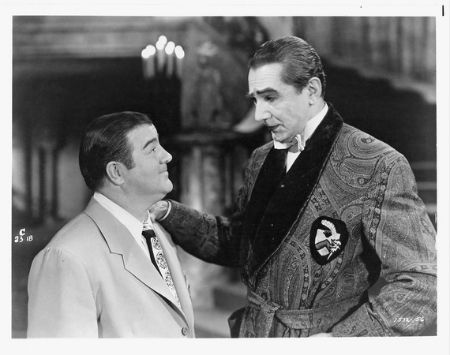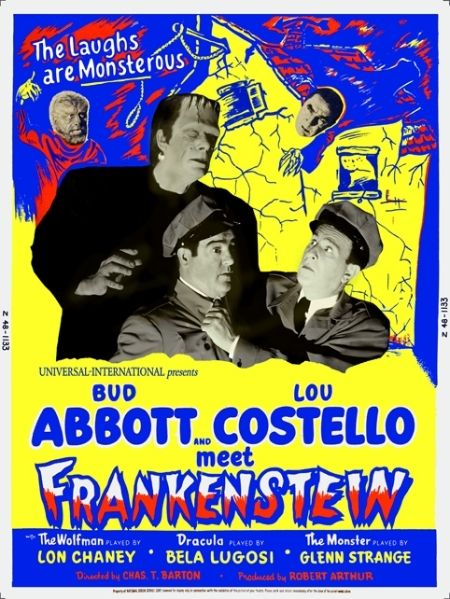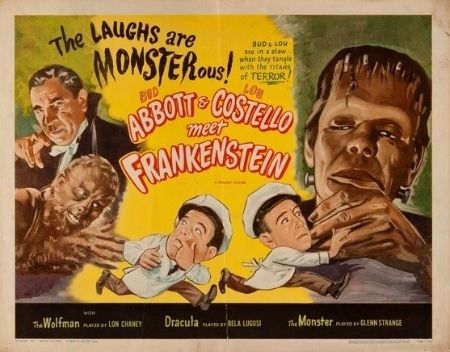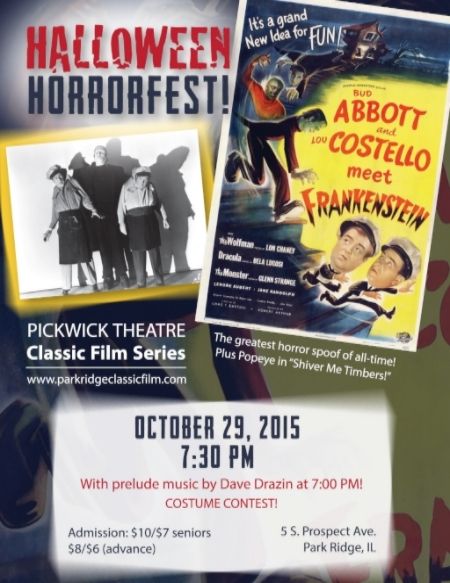WHAT: Abbott & Costello Meet Frankenstein (1948) on DCP
WHEN: October 29, 2015 7:30 PM
WHERE: Pickwick Theatre, Park Ridge, IL
WHAT ELSE: “Shiver Me Timbers!” (Popeye, 1934)
Musician Dave Drazin will be performing pre-show music on the Mighty Wurlitzer organ beginning at 7:00 PM.
We will have a costume contest (with prizes) for kids 12 and under.
HOW MUCH: $10/$7 seniors 60+ ($8/$6 advance tickets)
“Frankenstein gave the Monster eternal life by shooting it full of electricity. Some people claim it is not dead even now– just dormant.”
Chick Young (Bud Abbott) and Wilbur Grey (Lou Costello) are two baggage handlers who receive crates containing the remains of Count Dracula (Bela Lugosi) and the Frankenstein Monster (Glenn Strange). A stranger by the name of Larry Talbot (Lon Chaney, Jr.) tries unsuccessfully by phone to warn Chick and Wilbur of the danger they are in. The crates are transported to McDougal’s House of Horrors where they are unloaded. The contents, however, are far from dead. Dracula and the Monster escape from the museum with the Count planning to restore the Monster. With the aid of Dr. Sandra Mornay (Lenore Aubert), Dracula intends to give Frankenstein’s creation a new, pliable brain so that the Monster can be more easily controlled. The unsuspecting brain donor, however, is Wilbur. With the help of Talbot, the boys try to stop Dracula’s evil scheme.
Abbott & Costello Meet Frankenstein is simply the greatest horror-comedy of all time. Besides being a top-notch comedy, it also works as a legitimate horror film with some genuinely chilling moments. It is this quality that separates it from other “spoofs” like Young Frankenstein. Besides being one of Abbott & Costello’s finest films, Meet Frankenstein serves as a wonderful homage to the great Universal monsters of the 1930s and 1940s.
Abbott & Costello Meet Frankenstein is a film that remains an audience favorite. Comedy is a genre that works best when seen in a theatre; the crowd’s reactions to the movie are a good barometer of its strengths. Meet Frankenstein plays extremely well at theatrical screenings and always gets appropriate laughs from all ages. The film shows just how well Abbott & Costello performed in the horror genre. Who can forget Lou’s gasping terror, which only baffles Bud.
“What we need today is young blood– and brains.”

The irony is that, for all its success, then and now, Meet Frankenstein was a film that Lou Costello did not want to make. Although Abbott & Costello had considered doing a Broadway show in the early 1940s using the Universal monster characters, Lou wanted no part of the film and was unhappy with the script, originally called The Brain of Frankenstein. Lou was eventually convinced to do it, however, by the fact that they would be working with their favorite director, Charles Barton.
Barton’s career in movies went back to the days of silent cinema where he performed as an actor at the age of 15. In later years, he worked as an assistant director for Paramount on such films as Island of Lost Souls and Monkey Business starring the Marx Brothers. Barton was no stranger to horror and comedy. By 1948, he had already directed Bud and Lou in The Time of Their Lives, Buck Privates Come Home, and The Noose Hangs High. His films stand out considerably from those of Charles Lamont, who directed most of the other Abbott & Costello films at Universal. Abbott & Costello Meet Frankenstein features some of the most atmospheric lighting and camerawork (by cinematographer Charles Van Enger) ever seen in an Abbott & Costello film. (One early example is the mobile camera evident in the first scene at McDougal’s House of Horrors.) Perhaps the greatest benefit of Barton’s collaboration with A&C is that he got them to try things they wouldn’t have done for any other director.
Charles Barton: “Do you remember that pantomime scene where Lou sat in the Monster’s lap, and he got his hands mixed up with the Monster’s? Well, Lou didn’t want to do that. I had worked with (screenwriter) John Grant on that bit and when Lou read it he said, ‘What the hell is this?’ I said, ‘Well, if you just listen and try it, you’ll find out that it is beautiful.’ At first Lou didn’t understand it, but he finally became very enthusiastic. He just loved it. Well, we began shooting the scene and right in the middle of it, Glenn Strange started to laugh. And by God he couldn’t stop!” ~ Abbott & Costello in Hollywood (1991) by Bob Furmanek & Ron Palumbo
Meet Frankenstein‘s cinematic qualities certainly add to its classic status, but the film is primarily remembered for its great cast. This was only Bela Lugosi’s second appearance as Dracula–he only got the part at the last minute by the insistence of his agent– yet he dominates with the old magic that had captivated audiences 17 years before in Dracula. Bela is commanding, and his delivery of his lines are some of the best moments. (It’s unfortunate that this would be his last film for a major studio.) Lon Chaney, Jr., reprises his role of the Wolf Man for the fifth and final time onscreen, once again projecting those qualities of anguish and torment associated with Lawrence Talbot, cinema’s patron saint of lycanthropy. Glenn Strange returns as the Frankenstein Monster, which he had played in the earlier House of Frankenstein and House of Dracula. This time, Strange wore a more efficient makeup designed by Bud Westmore and Jack Kevan, which replaced the time-consuming process of the great Jack Pierce. And finally, for Abbott and Costello, this was their comeback film which restored them as box office champions.
Bud Abbott, the greatest straight man, and Lou Costello were experts at what they did, whether it was those methodical word games or the timing of their lines. Their appeal rested in the stage routines where it didn’t matter who the director was. They came from the burlesque tradition on stage and quickly became stars in radio and on film. They were the most popular comedy team until post-war America sought uninhibited, unhinged, and juvenile behavior in their entertainers. Abbott & Costello Meet Frankenstein downplays the Abbott & Costello routines, and as a result, the two comics blend in more seamlessly with the plot. The film does feature the “moving candle” gag, which was a routine they had developed in vaudeville and used later in 1941’s Hold That Ghost– the first A&C film to combine comedy with horror.
Lenore Aubert, the film’s femme fatale, with the hypnotic Bela Lugosi.

Lon Chaney, Jr. believed, in the years after the film’s release, that Abbott and Costello killed the horror genre. For Chaney, the sympathy that audiences had developed for these monsters was now gone. But time has proven otherwise. The quality of movies like House of Dracula did more to kill off the monsters than anything else. These later monster movies, made during the latter part of World War II, were B-movies cranked out mechanically and remembered today mainly out of nostalgia. By contrast, Meet Frankenstein is genuinely inspired and features a climax far more exciting than anything in either of the House pictures. Most importantly, the monsters play their roles straight and retain their dignity to the very end.
Abbott & Costello Meet Frankenstein is the final curtain for the Universal monsters. It benefits from a great script, solid direction, atmospheric sets, a wonderful score by Frank Skinner, and a stellar cast of horror greats with two comics captured at their best. There are so many details and nuances that make this a rewarding film.
When this famous monster rally comes to the Pickwick Theatre on October 29, we’ll be presenting a film which has touched so many people at so many age levels. Its legacy, like the monsters themselves, is eternal and will go on for as long as movies exist.
~MCH





One thought
Comments are closed.